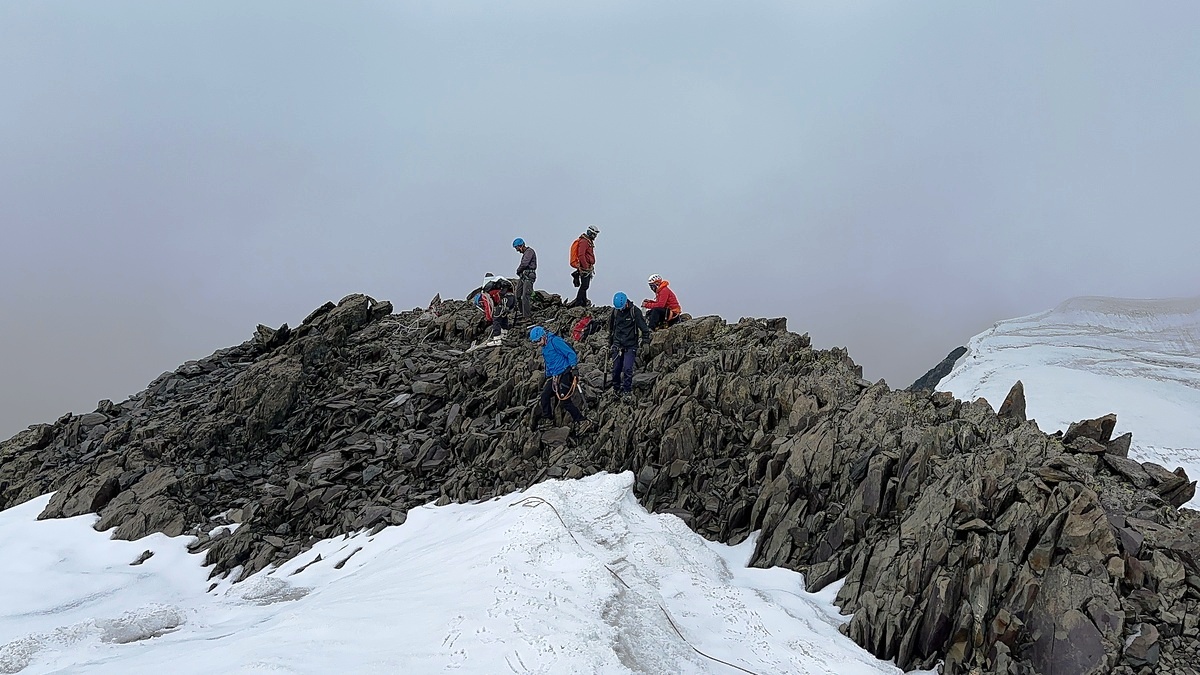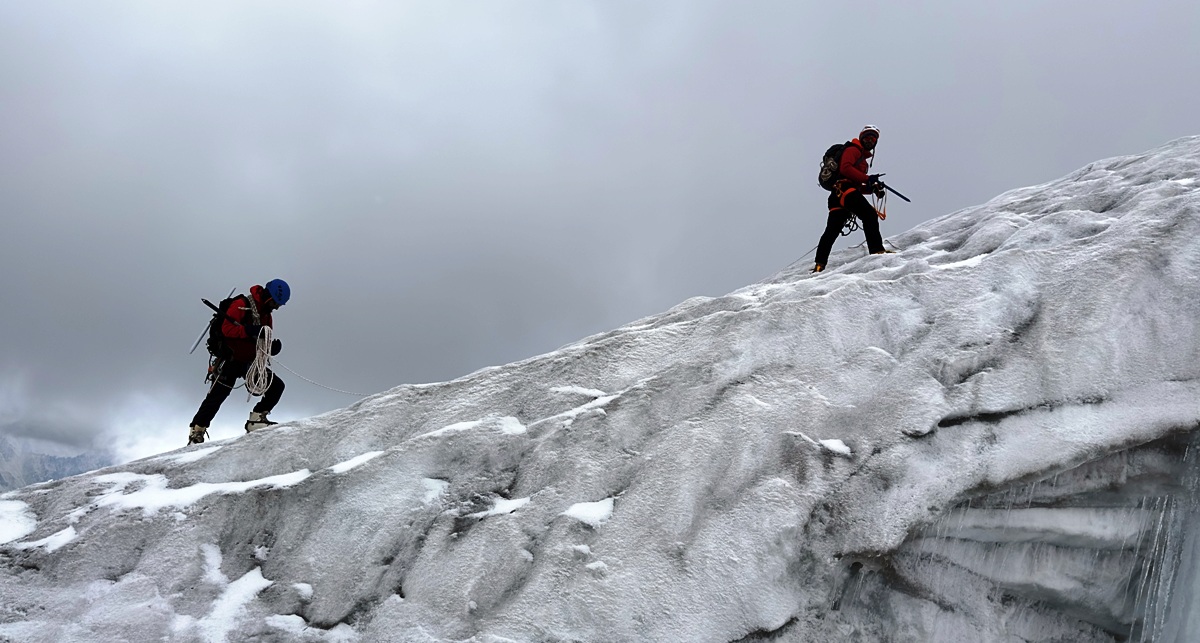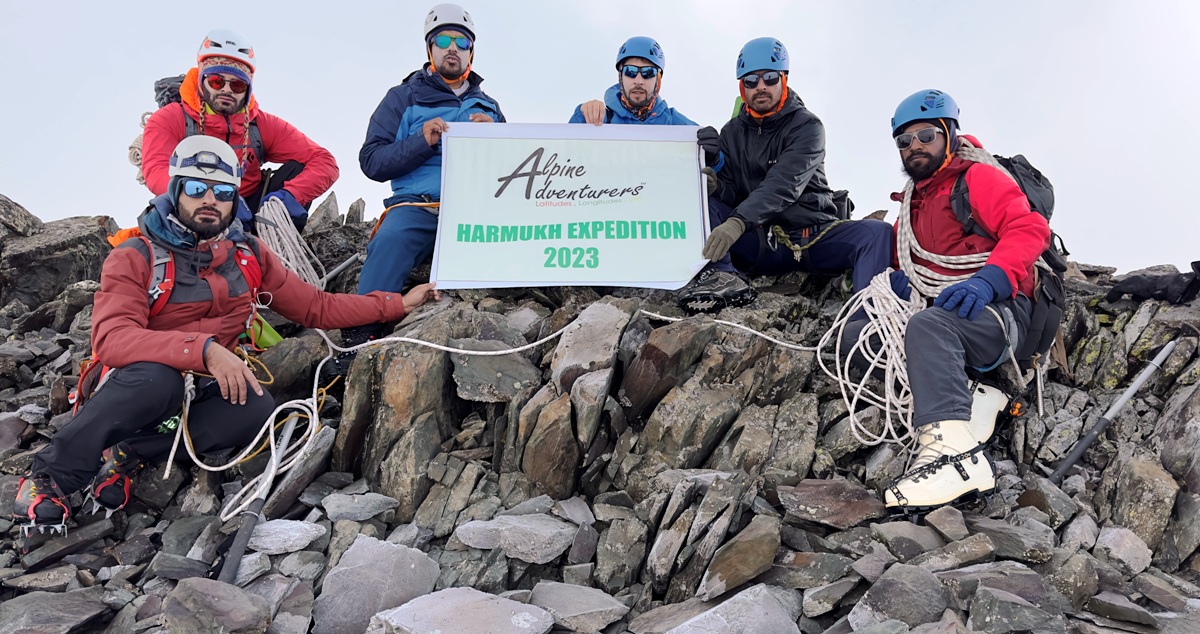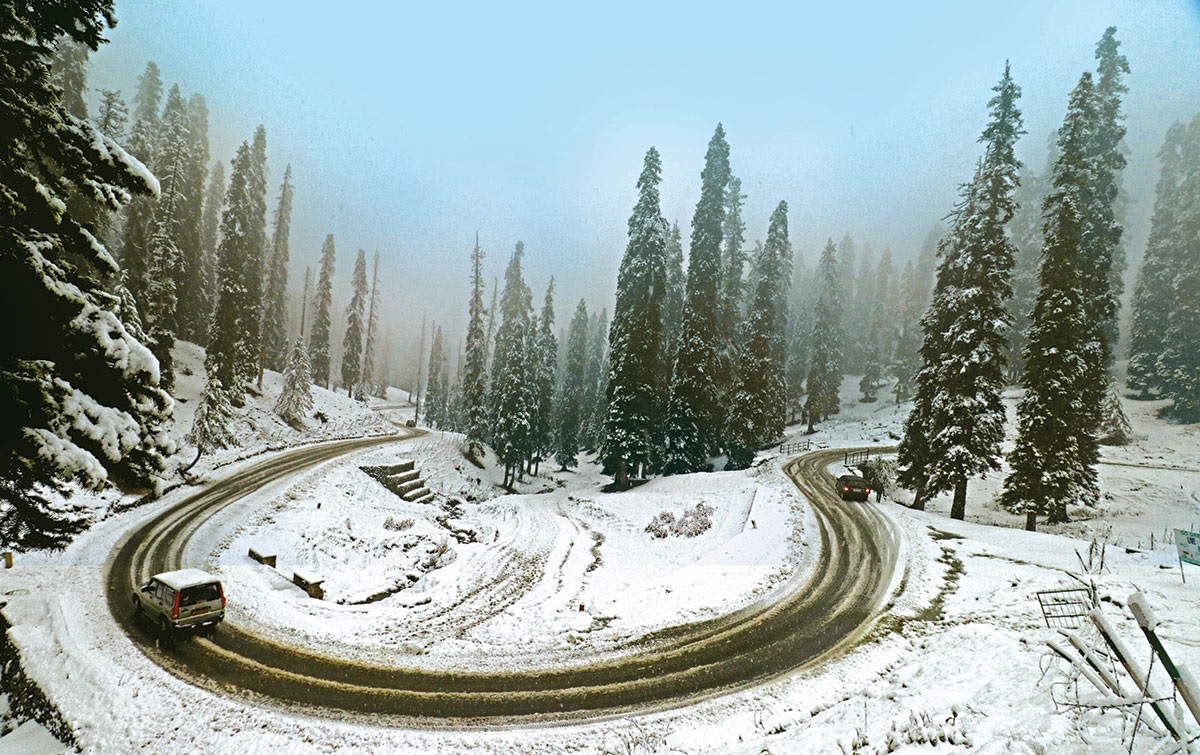On September 5, 2023, a team of mountaineers (Alpine Adventurers) climbed Harmukh Peak. Taous Zahoor Baba was part of the team and he wrote the details of the exciting ascent involving glaciers, cliffs, crevasses and the precious view that the peak offers of the valleys below

Huddled high in the breathtaking Himalayas lies Mount Harmukh, a towering giant that watches over the serene Gangabal Lake. At 16,890 feet, its snow-capped summit pierces the clouds, standing guard over the valley below. Local legend whispers that Harmukh’s gleaming emerald vein renders venom harmless, creating a sanctuary safe from snakes. The mountain’s formidable north face evokes comparisons to the mighty Eiger.
The mighty peaks of the Himalayas have captivated adventurers for centuries, like a siren’s song beckoning them higher. As a mountaineer, I am continually drawn to test myself on new summits, to revel in the beauty of the high places, and to bond with like-minded comrades. My most recent quest took me with the Alpine Adventures group to the majestic Mount Harmukh in Kashmir. At 16,870 feet, it is the third-highest peak in the Kashmir Himalayas.
Located in Ganderbal, it offers an aesthetic view in the backdrop of Gangbal Lake. It is believed that Harmukh was first scaled by the members of the Great Trigonometric Survey in 1856. From his station at Mount Haramukh, Thomas Montgomerie, a British surveyor who participated in the Survey as a lieutenant in the 1850s, labelled the highest visible stations of the Karakoram Range as K1, K2.
Team Alpine Adventurers previously scaled Mount Haramukh in September 2015 under the leadership of Aadil Shah, which in the history of Kashmir adventure, turned out to be the first successful attempt after a gap of 35 years.

Our journey was filled with camaraderie, intense effort, and magnificent vistas. We gathered in the bustling capital of Srinagar to organise for the trek ahead. Alpine Adventures is known for tackling technical climbing objectives, and I was proud to be part of the team. We spent two days purchasing supplies, checking equipment, and poring over topo maps. Finally, we piled into jeeps and set off for the remote village of Kudara in Bandipora. The 65-mile drive took us deep into the Himalayas, past the Lidder and Sindh rivers and through sweeping mountain scenery.
Arriving in quaint Kudara, we received a friendly welcome from the villagers. After a good night’s rest, we continued 12 more miles to Sarbal Lake, a stunning high-altitude lake nestled at 11,548 feet. This tranquil spot would be our base camp, with Harmukh’s summit still soaring above. We quickly pitched tents on the lakeshore, the icy waters and sheer cliffs making a spectacular backdrop. Settling in around the campfire that night, we shared stories and psyched ourselves up for the big climb.
The following morning, I awoke invigorated and eager to push higher. But the weather gods had other ideas. Ominous clouds now shrouded the upper slopes of the 17,000-foot massif. After much debate, we decided to hold off, hoping the skies would clear. We used the time to scout potential routes using binoculars and telephoto lenses. Harmukh has three subsidiary peaks – North, Eastern, and Western summits encircling the main central summit. Identifying a safe path through this rugged terrain would be critical.
The next day brought relief, with sunny skies and stabilised weather. We were raring to go. Leaving a small contingent at base camp, our summit team of eight set off loaded with gear. We ascended toward the Harmukh Glacier, passing below the Western and North peaks. The steep route was strewn with scree, making the going tricky. We had to tread gently, as one dislodged stone could trigger hazardous rockfalls. I was grateful for my top-notch climbing partners, we moved efficiently together.
Many years back, Mohammad Ashraf, a mountaineer who was also Director General Tourism, and his team had to call off the mission to Haramukh after they were caught in a large stonefall. In fact, a small boulder hit him on his knee, leading to the failure of Mission Harmukh, according to his own writing Traversing Kashmir Alps-The Haramukh Failure.
In almost no dissimilar situation, our team lead, Arshid had to retreat back, as he had an ankle twist and Tahir had to accompany him. It was demoralising as the two most experienced members retreated to the base. So Kursheed Sahab took the lead. The screes turn at a gradient of 65 degrees, so one had to be cautious. We pushed ourselves all the way to the top of the ridge, landed in the colossal snow fields and set our ABC (Advanced Base Camp).

After surmounting the loose slope, we traversed to the glacier and scouted a location for our advanced base camp. In 2015, we had set our advanced campsite at Nandlal Bakaya Point, a spot identified by Bakaya in his book as the dip on the ridge which is good enough for one tent. This time, however, our plan was to set the advance campsite on the Haramukh Glacier, a colossal snow field. We were able to reach the exact spot and therefore were able to successfully set our advance camp at an altitude of 4750 mts.
We found a reasonable site at 15,580 feet and quickly dug out tent platforms in the snow. As we settled in for the night, the clouds parted to reveal an incredible vista. Soaring Nanga Parbat, rising over 26,000 feet, could be seen down the valley. Closer by, the emerald waters of Sarbal Lake sparkled 1200 feet below. It was a sight to behold.
Rising before dawn, we suited up and headed out in the crisp morning air. A maze of crevasses and seracs peppered the glacier, but we zig-zagged around them towards the saddle. Topping out at 16,540 feet, we began the final push to the summit. The slope steepened as we ascended the last 1,300 feet. Digging deep, I savoured the intense exertion and stark grandeur all around. The roof of the world spread out before us.
The hours of effort paid off as we finally crested the summit ridge on September 7, 2023, at 11 am. We cheered excitedly at achieving our goal of 16,870 feet. The staggering panorama took my breath away. We posed for photos beneath our flapping banners, elated and proud. We could identify the shimmering lakes of Gangbal and Nundkul along with Indersar and Shoksar. And peering west, the distant giants of the Karakoram Range – Masherbrum, K2, and the Gasherbrums could be located.
On the way, we reached the spot where Rajinder Kaul and his party had raised a few poles, as a mark of their successful summiting the spot. The poles were still standing tall.
For expert climbers seeking adventure, Mount Harmukh offers an alluring challenge. The best months to attempt the basic snow and ice climb are June through October. With planning and skill, you may be lucky enough to experience Harmukh’s beauty firsthand, joining the rarefied ranks of those who have summited this Himalayan jewel.
After paying our respects at the cairn built by the first ascent team in 1856, we began the long descent. Carefully we picked our way back down the icy slopes toward camp. Returning exhausted but fulfilled, we celebrated late into the night, reminiscing on the climb. Though it was time to return home, the spell of the mountains was as strong as ever. I knew I would soon yearn for the next adventure on a far horizon. For the heights continue to call me, like an unquenchable thirst. And I will keep answering.
(The author is a banker and one of the founding members of Alpine Adventurers. He wishes to thank expedition sponsors – Pine Foods And Zaffron Pvt Ltd, Jammu and Kashmir Tourism department, Arif Mountaineer , Junaid Dar, and Javeed Shah for providing the necessary equipment besides Mahmood Shah.)















